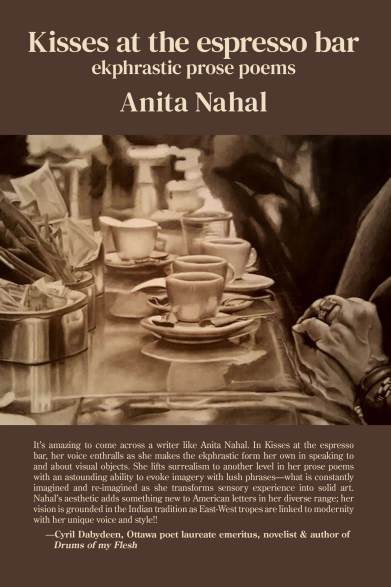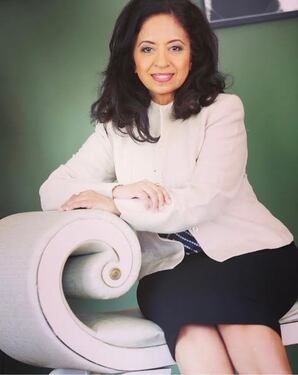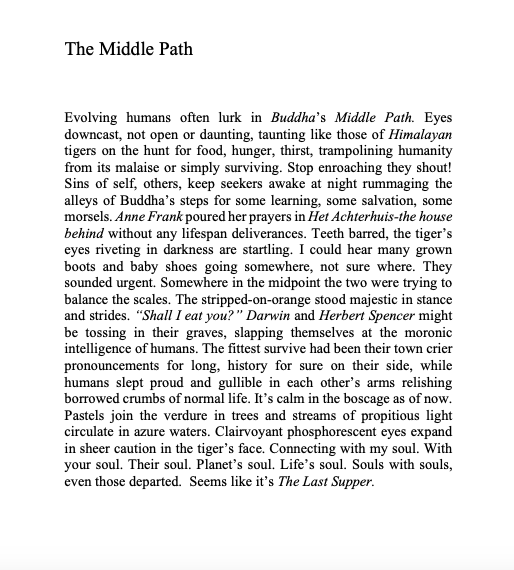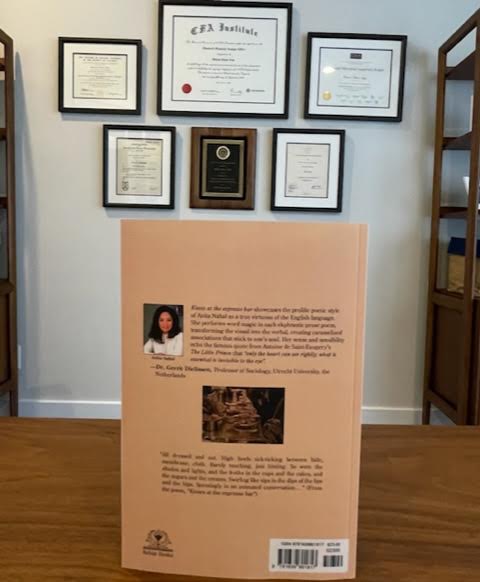|
Kisses at the Espresso Bar: Ekphrastic Prose Poems Kelsay Books, 2021 The Ekphrastic Review was delighted to talk to Anita Nahal about her latest book, Kisses at the Espresso Bar: Ekphrastic Prose Poems. Lorette C. Luzajic, The Ekphrastic Review: What moves you to write about a particular artwork? How do you choose the art that you will write about? Anita Nahal: I am drawn to artwork that speaks to me emotionally. One with which I can immediately connect at a deeper cerebral level. Something about it is unique, unusual, not simple, because life is not simple. Therefore, one from which I can derive esoteric or unknown or unimagined meanings. Yet, not abstract art. It could be either hyper realist or surrealist. Those are the kinds of artwork that move me to write. Tell us about what the ekphrastic process is like for you. How long do you spend with an image? Where do you work? Do you write in a single burst, or return to the artwork and your poem continually? Ah…many lovely questions! Well, once I see an artwork that appeals to me, I am desirous of writing down my thoughts and words quickly lest I forget them! However, after the initial outpouring, I marinate over the image and my words and its possible that a whole new set of words might emerge. So, it’s never in a single burst! Also, I like to revise my poems a lot. Long after these are written or even after these are published!! The best time to write for me is very late at night or very early in the morning, either in our study, or sitting near a window looking out or snuggled in bed. However, some of my best poems have come suddenly and sitting in the thick of everything at a coffee shop! When folks come to know that I am an avid yoga practitioner, they ask if I meditate. I suppose meditation is a natural corollary to yoga, or to being from India. In any case, my response is, no, I don’t meditate. At least not in the traditional sense. Sitting at a coffee shop, with music on, with folks talking, in the midst of noise if I can pull myself in and focus on writing poetry (that I end up really loving), that is meditation for me. I also end up writing poems when I am cooking and listening to music at the same time! There’s something delicate, subtle, and indeed valuable to the human body about preparing food to be eaten (especially for others) and jamming alongside to my favourite music helps me to focus on my thoughts and words. Also, something about multitasking gets me going in more than poetic ways. I work best under pressure and doing many tasks at the same time. I’m honoured that you chose several of my own artworks to write to and feature in this book. How or why did my mixed media works inspire you?’ Ah, see, life is an amalgam of mixed elements, people, situations, thoughts and therefore, your eclectic, mixed media works struck a meaningful chord in me. I could see things beyond what was obvious as your artwork is very reflective and insightful. And I could see mixed art elements of varied kinds in your paintings which I found very intriguing. Your art gave me the opportunity to further explore the layers and dimensions of life. Your art also meanders in the realm of surrealism, an art/creative form that I find most captivating. What kind of art are you most interested in, as a writer and in general? I am most interested in two art forms that lie in extremities, the hyper realist, and the surrealist. The seven artists whose creativity is displayed in my book alongside my poems, including yourself, display a range of art from hyper realism to surrealism. In hyper realist art I find reality staring at us in its basic raw form and in the surrealist, I can imagine that which is not there in reality. Mind you as a weaver of words, both in hyper realist and surrealist art, I can conjure up or dream or wish for anything. Generally, in life as well, I am most interested in these two art forms, hyper realist, and surrealist. Realist art has many critics who find the very fact that it's realist as not art. However, I believe realism assists humans in remaining grounded in normalcy, which is critical for day-to-day survival, physically and emotionally, not to forget, professionally and financially. Andrei Tarkovsky said it eloquently when he explained that “Art is realistic when it strives to express an ethical ideal. Realism is striving for truth, and truth is always beautiful. Here the aesthetic coincides with the ethical.” And then, surrealist art stands as its alter ego by tempting humans to escape into other worlds and realities that the human mind is not aware of or capable of accepting. It can be dark, scary, and unattainable. It can also be very beautiful, calming, and reachable. It depends upon who is viewing whom or what. Says, Frida Kahlo, “Surrealism is the magical surprise of finding a lion in a wardrobe, where you were 'sure' of finding shirts.” Your poems widely reference a range of cultures and cultural influences, from art to religion to popular culture, from many backgrounds, making each poem almost a kind of collage. Tell us about your curiosities other than visual art, and how they inform your writing. Thank you for saying so! I am very glad you got that from my poetry! I was raised with an acute awareness and recognition of the precious benefits we can secure from diversity and inclusion. So, when I write, my mind and thoughts go to different societies, geographical locations, popular culture and historical sites or artifacts to find connections and symbolism which I then employ in my poetry. I also chose and seek on purpose, to find examples from varied cultures so that my poetry reflects the inclusive notions in which I inherently believe. Sometimes I research and find those nuggets of cultural symbolism, in other cases my memory helps me in recalling something. How does your Indian American heritage inform your poetry and your aesthetics as a writer and a woman interested in the visual arts? You know it’s very special that some of us get to travel to different places from early on in life and keep travelling in our adult years as well. Our parents took my sister and I with them wherever they could. Influenced by that pattern of upbringing it was but natural that I too started taking my son abroad or elsewhere within the country from his young age. Being an immigrant who believed in integrating the best of both worlds, I tried my very best to learn from both the dominant cultures in my life—Indian and American. Just travelling, and being an immigrant changes a person significantly and impacts the way we think and do. On top of that I am a writer and a woman and a single mom. All those myriad layers of my identity have shaped me, which I’ve attempted to share in my poetry as well. My hope is that someone reading my poetry will find themselves in its lines and nuances. Therefore, my poetry is written, I think, in a way that can be universal. I write with the intent to share my Indian, American, female, single mother experiences surrounded in a gamut of universal experiences governing or molding and influencing humanity. At least that’s my hope. How does this collection of poetry differ from your previous books? What does it share with them? So, thematically, all my four poetry books published between 1988-2022 somehow or the other bring out the injustices, myriad “isms”, double standards, duplicity, conceit, ego, and other similar tendencies that are inherent human traits. Structurally, this collection is entirely composed of poems inspired by art in some form, be it mixed media, sculptures, paintings, graphite pencil drawings, quilt work and so forth. Also, all the poems in this book are prose poems like those in my third book, What’s wrong with us Kali women? (2021) and to some extent in my second book, Hey, Spilt milk is spilt, nothing else (2018). The second (Hey…) and my first book Initiations published 34 years back find similarity in the sense that some of the poems in both are short and free verse. This book, Kisses at the espresso bar, and my second book, (Hey...) share another characteristic. I converted pictures in to pencil line drawings for each poem in the Hey… book. And of course, the last book, Kisses… is entirely ekphrastic. I am a visual learner and have always been interested in depicting my poetry. What’s next for Anita? A long break lol! I feel a sense of inertia and have not felt like writing poetry for over a year now. I have written just a handful when some folks have persisted that I write for journals they edit or anthologies they edit. I feel I have poured out my emotions sufficiently on several themes related to injustice. I don’t see humans changing or societies improving. So, as a writer I feel a sense of malaise at my inability to change the world. Also, perhaps because I am a creative person and I am very sensitive, I observe the jealousies and extreme negative competitiveness among writers and that saddens me and prevents me from writing these days. Though of course even if I can positively impact one person, I am happy with that since it could lead to a domino effect, I hope. I recently completed the 16th revision of my first novel. I have been sending it out to agents and publishers. Already, I’ve had double digit rejections which is okay, it’s a normal process of writing and sharing. If it doesn’t get accepted, I will probably write another novel, some magic related or surrealist kind of novel. Let’s see where those thoughts take me. ** Scroll down to read selections from Anita's book. Visit Anita online to learn more about her and her work. Selections This poem also appeared at YapanChitra. This poem also appeared in Kaleidoscope Anthology. This poem also appeared at Cathexis Northwest Press.
0 Comments
Your comment will be posted after it is approved.
Leave a Reply. |
The Ekphrastic Review
COOKIES/PRIVACY
This site uses cookies to deliver your best navigation experience this time and next. Continuing here means you consent to cookies. Thank you. Join us on Facebook:
July 2024
|













